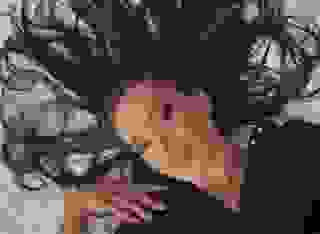- Loving Wives
- Darla's Dilemma
Note: You can change font size, font face, and turn on dark mode by clicking the "A" icon tab in the Story Info Box.
You can temporarily switch back to a Classic Literotica® experience during our ongoing public Beta testing. Please consider leaving feedback on issues you experience or suggest improvements.
Click hereFor more background on many of the characters in this story, please read the following:
What Mother-in-Law Wants
Badge of Betrayal
Clarissa Gets Served
Grab Life by the Balls
The Ghost of Red River Falls
This story also contains some graphic descriptions of domestic abuse. If you or someone you know is currently in an abusive relationship, please seek help or get them help. Domestic violence is a crime that should be tolerated by no one. If you have been a victim of domestic violence and think that stories of this nature may be upsetting to you, then please do not read this story.
For all others, I hope you enjoy the offering. As always, comments and CONSTRUCTIVE criticism are always welcome. If you're just here to throw hand grenades, your comments will probably be deleted - especially if you post anonymously. Go be a jerk on someone else's time.
SB
Darla's Dilemma
A Red River Falls Spinoff Story
The long single tone of the pager went off at 02:47. Immediately I bolt upright in bed, flip on the nightstand light and spin sideways to plant my feet on the floor and listen to the dispatch.
"Attention Eagle Star pilot and crew, attention Eagle Star pilot and crew. Mason County Sheriff's Office is requesting your response for a motor vehicle collision with injuries on Highway 120, approximately 15 miles south of Red River Falls. Martindale Fire and Rescue are on scene. Accident involves a single-vehicle rollover. One fatality confirmed. Martindale Fire and Rescue advises prolonged extrication in progress. Time of call 02:47."
I quickly stand and zip up my flight suit and step into my boots. I grab the handheld radio next to the bed from its charger and begin making my way to the front door of the EMS crew apartment at Holy Family Medical Center. I hesitate long enough to hear the pilot and flight nurse acknowledge the call.
"Pilot copies. Pending weather check," Gene Emory, our pilot, replied.
"Nurse copies," Mara Kendrick, my nurse and partner, replied.
I thumbed the button on the Motorola handheld. "Paramedic copies."
"Ten-four. Crew copies, pending weather check."
Gene stopped by the pilot's desk and quickly brought up the weather page on the computer. Ceilings were unlimited, visibility greater than ten miles, winds light and variable with no gusts exceeding 10 miles per hour. Lunar illumination was 64%. The conditions for night flight didn't get much better.
"Holy Family base, Eagle Star will accept the flight," Gene advised.
"Copy. Accepting flight. Will advise Mason County deputies and Martindale Fire."
The three of us grab our gear and helmets and head for an express elevator, which will take us from the sixth floor to the ground floor immediately. Our helipad is located on the east side of Holy Family Medical Center and directly in front of the new $80 million Emergency Department. Sitting on that pad is our magnificent helicopter, a twin-engine Bell 429 Global Ranger air ambulance in her stunning two-tone silver and royal blue paint scheme.
Mara secured our EMS jump pack in the rear-facing seat just behind the pilot, who sits in the right front seat of the ship. With over 200 cubic feet of space there is ample room for the pilot up front, for Mara and I in the back, and for the ability to transport up to two patients.
Mara's seat swivels and slides on rails so she can either attend the patient from the side or she can manage the airway of a second patient, if necessary.
I secured the Zoll Propaq MD cardiac monitor in its place. We'll use that to monitor our patient's blood pressure, oxygenation, heart rhythm and other vital signs once he or she is on board with us.
I secure myself into my left-side rear-facing seat. I will be at the head of the patient once we pick them up. We can either load patients from the rear of the cabin underneath the tail boom or they can be loaded through the side doors of the ship. My primary job in flight will be airway management and monitoring the patient's vital signs.
My flight helmet is the last thing I don before closing the side door of the ship. I bring my Pinnacle PVS-23 Night Vision Goggles into place and begin checking my vision. The world around the ship erupts into varying shades of gray and black. Objects previously unseen present their shapes in perfect clarity. In particular, I make sure I can effectively identify utility poles, power lines and communications towers - all of which are some of the greatest threats to nighttime flying.
From his pilot's seat Gene yells, "CLEAR!" and he punches the actuator button that brings the Bell 429's powerful twin Pratt and Whitney PW-207D1 engines on line. The engines begin the windup process that, when they are at full power, will each deliver 730 shaft horsepower to the ship and generate enough power to reach speeds of 150 knots. The strong smell of Jet A fuel begins permeating through the cabin but is quickly dissipated once the ventilation systems kick in.
Once the engines are spun up, Gene calls out to Mara and I on the internal coms. "Crew and mission equipment ready for takeoff?"
"Ready on the left," I reply. "I have green in both tubes. I can see up, down and around. Belts, doors and switches secure."
"Ready on the right," Mara echoes. "I have green in both tubes. I can see up, down and around. Belts, doors and switches secure."
"Pilot copies crew and mission equipment ready for takeoff," Gene acknowledges. "Holy Family Base, Eagle Star Helicopter November-Niner-Niner-Four-Alpha-Lima taking off from Eagle Star base. We have three souls on board and two hours and thirty minutes of fuel. ETA to the scene is approximately six minutes."
"Eagle Star, good copy. Time of dust off, 02:52. Godspeed."
Gene brings the Bell 429's throttle to full power and a brief shaking occurs as the big helicopter strains against gravity while he pulls up on the collective. The 429 wins the fight and begins a smooth assent to a height of approximately 300 feet to ensure we are well above the height of the hospital building.
"Coming left," Gene says.
"Copy. Coming left," I reply. I give a quick scan and ensure there are no potential obstacles in our way.
"Clear right," Mara says, as she does the same. It is her job to look to the right as that is the direction the tail of the helicopter will swing in a left turn maneuver.
We've done this take-off maneuver in all directions hundreds of times ever since Holy Family has had a helicopter service. With the big Bell 429 facing south, Gene nudges forward on the stick and we begin racing southward towards the scene of the accident. I quickly thumb the switch on the main radio to the "mutual aid" setting so I can contact the Mason County Sheriff's Department and make sure the deputies and Martindale's first responders have established and secured a landing zone.
"Mason County Sheriff, this is Eagle Star. How do you copy?"
I wait a few seconds before hearing, "Eagle Star, this is Mason County 17-21."
"17-21, can you please advise if the landing zone has been secured?"
"10-4, Eagle Star. The scene is just north of Mile Marker 99. The vehicle is off the road approximately 80 feet. We have both north and southbound traffic stopped and a guard is posted to watch your tail rotor."
"Good copy, 17-21. Can you advise if the extrication is still in progress?"
"Eagle Star, it looks as if they are just about to get the victim out of the vehicle and onto a board."
"Good copy, 17-21. ETA is less than three minutes."
"10-4, Eagle Star. We're awaiting your arrival."
I craned my head and neck to try and look behind me as much as possible, which was to look towards the front of the helicopter. Through the canopy window I could see numerous red and blue flashing strobe lights indicating that we were less than two minutes from landing. Gene brought the big helicopter into a wide sweeping arc to give us all a view of the scene. He eventually brought the nose of the aircraft facing north.
"We got power lines on the east side of the roadway, Gene," Mara advised.
"Copy. I got eyes on," Gene confirmed. Again, communications towers and utility poles and wires were among the biggest threats to a helicopter attempting to land in the dark. Gene kept his eyes steady on his altimeter and, with his view through his night vision goggles, he executed yet another flawless landing right on the hard asphalt of Highway 120.
"Holy Family base, Eagle Star is on scene. Preparing for a hot load and go. ETOS ten minutes." ETOS is 'Estimated Time On Scene'.
"Good copy, Eagle Star. Time is 02:59."
I took my helmet and goggles off and gently set them on my seat after I unbuckled. The first thing I grabbed was my stethoscope so I could listen to lung sounds of the patient before loading them into the helicopter. Once on board, I'd never be able to hear anything. I also grabbed our jump kit, which contained the bulk of our medical supplies, including everything for a trauma.
I debarked from my side of the ship and immediately started looking for the Incident Commander. Several fire trucks were on scene and had the scene of the accident lit up fairly well. The vehicle, a two-door Camaro, had left the highway and rolled multiple times. The vehicle was probably a good 60 or 80 feet from the road and somehow had managed to land on all four wheels, although it was heavily damaged.
I found the person I was looking for, one of the Martindale volunteer firefighters, who happened to be wearing a red helmet while all of the others were wearing yellow helmets.
"Hi. My name is Daulton Anderson," I yelled over the roar of the still-running chopper. "What can you tell me so far?"
"We have one confirmed fatality," he shouted back. "The driver of the vehicle wasn't belted in and got ejected. He's under that yellow tarp out in the field," he said, pointing to a spot that was almost another 80 feet from where the vehicle landed. "They were going northbound, headed back to Red River Falls. Lost control and flipped over ten times before striking that giant dead oak tree on the passenger side. Probably doing 80 or 90 mph, maybe even faster. The passenger is a female. She's got at least one broken arm and possibly a busted femur, at least that's what the first responders said. I can't believe she's still alive. Oh, looks like they've got her out now!"
I saw a group of firefighters and EMTs carefully placing the patient on a back board. They had a cervical collar in place and I could see her moving her left arm for sure. One of the EMTs was holding the right one in place and trying to apply a splint. I rushed down to the area where they were working on her.
"Don't worry about applying a splint," I instructed. "As long as there is no bleeding, just place the arm next to her body and strap her down to the back board. What else is wrong with her?"
"She's probably got a busted femur and busted tib-fib, both on the right leg," one of the responders said. "Not sure, but we think she might have a broken pelvis, too."
"Set her down and let me do a quick assessment before we load her," I directed.
The female was fairly young, probably 23 to 27 years old. She had numerous cuts all over her face, which made her look worse because the face tends to bleed a lot, even from minor wounds. She also had a non-rebreather oxygen mask in place. I quickly scanned her pupils, which were sluggish but equally reactive to my pen light. There was no blood coming from her eyes, ears, nose or mouth. The smell of alcohol was prevalent as I got close to her face. Most ominous, she didn't really react verbally and was obviously in shock.
The right thigh was significantly larger than the left, indicating an obvious femur fracture and bleeding heavily inside. And she shrieked in pain when I pushed in on the sides of her pelvis. I could also feel movement in the pelvis as I applied pressure - a surefire sign that the pelvis had fractured. Normally, we would apply a traction splint to reduce the femur fracture in the field. But putting one on in this case would only pull apart the broken bones in the tibia and fibula and do nothing for the more serious femur fracture, which can bleed - A LOT.
Her left lung sounds were good and active but the right lung sounds were severely diminished and her right rib cage was heavily bruised, indicating multiple broken ribs but no flail segments, which are ribs broken into places. More importantly, it was obvious that the trachea was starting to shift to the left, indicating that the right lung was collapsing. When this happens, the lung doesn't really deflate. Instead, air starts to build up in the space between the lung and the chest wall, which increases pressure on the lung, thereby causing it to "collapse". In reality, it is trapping air that will not allow the lung to inflate properly and basically squeezes it shut. Also her abdomen was rigid and firm with no audible bowel sounds present, which was another indication of internal bleeding.
I quickly reached into my flight suit's side cargo pocket and grabbed a quick set for an IV. I applied a tourniquet quickly and found the patient still had a good left antecubital vein, which is on the inner part of the elbow, as the left arm did not appear to be injured. I quickly stuck a large 16 gauge catheter in the vein and applied a saline lock, which is a short piece of closed IV tubing that can be connected to longer tubing later to administer IV fluids. I flushed the IV quickly with a 10 milliliter syringe of fluid to ensure the IV was good and secured it with a transparent dressing and tape. The IV stick only took about 90 seconds. Then I shouted "Helicopter! Now!"
Normally, we didn't delay transport to do an IV but I felt it was imperative to get the IV quickly as she was going deeper into shock. The more her blood pressure dropped, the more difficult it would be to get IV access.
The group of EMTs and firefighters scooped up the backboard and patient and we moved to the roaring Bell 429. Mara had the clamshell doors open on the back. I stopped our group and made eye contact with the pilot and Gene gave us a thumbs-up to proceed to the loading area. Absolutely NO ONE approaches the tail of an active helicopter without the pilot's knowledge. Mara met us there and we secured the backboard into place on the left cot, slid her into place in front of my seat and climbed aboard, thanking the EMTs and firefighters for doing a great job. One of them handed me a slip of paper with some patient info on it before they all ducked low and walked away from the helicopter.
I immediately placed my helmet back on and buckled into place as Mara slid her seat into place alongside the patient. She immediately applied the blood pressure cuff and pulse oxymetry probe to the patient and switched her oxygen mask's line to our onboard oxygen system.
"What all do we have, Daulton?" Mara asked over the intercom.
"Fractures of the right humerus, right femur, right tib-fib. No traction to the right leg possible. Possible pelvic fracture, as well. Gonna need to apply a tie-sheet to reduce. She's also working on a right-side tension pneumothorax. We've got tracheal shift to the left side. Tummy is hard and tender and I heard no bowel sounds."
"Okay. I can see the shift. Let's go ahead and get ready for decompression. Let's work on reducing the pelvis and we'll see how her BP is afterwards after we hang fluid. We'll also get Tranexamic Acid hanging, as well. Gene, we can take off but I'm gonna need to unbuckle once we are on our way, okay?"
"Copy," Gene acknowledged. It was extremely important to let Gene know everything that was going on in the back, as much as possible, especially if we needed to unbuckle and move around in the back of the ship as it can affect flight characteristics.
Once we have a patient on board our call sign changes from "Eagle Star" to simply "Lifeguard", which is a signal to all aircraft in the area to give us priority clearance. Also, we fall under the control of Hector International Airport out of Fargo to maintain our airspace clearance.
"Contact, Hector International. This is Lifeguard Helicopter November-Niner-Niner-Four-Alpha-Lima. We are dusting off from the scene, en route to Holy Family pad, heading three-five-five, speed one-two-zero knots. We have four souls on board and approximately two hours and 10 minutes of fuel. ETA eight minutes."
"Lifeguard November-niner-niner-four-alpha-lima, Hector International. Good copy. I have you on radar. Maintain current speed and heading. You are clear for priority approach to Holy Family pad. Copy ETA of 8 minutes."
In the back, I quickly exposed the right breast area of the patient and palpated the area between the 2nd and 3rd rib and referenced that with the nipple line. As I did so, I noticed through my gloved fingers that her skin now felt like rice paper. Thousands of tiny air bubbles were forming under the skin, which is called subcutaneous emphysema, from the collapsing right lung. I quickly scrubbed the area with an iodine swab and grabbed a large two-inch long 14-gauge IV needle. I pushed straight downward through the skin and felt a "pop" sensation once the needle penetrated the right lung space. I pulled the metal stylette out while holding the hollow plastic catheter in place and was greeted with a quick hiss of escaping trapped air and some bloody bubbles from the right lung. It was a temporary fix until the patient could get a chest tube in place. But it helped equalize the lung pressure and allowed the right lung to begin "inflating" again by getting rid of the trapped air.
Mara grabbed an extra bed sheet and slid it underneath the patient's buttocks as gently as she could. Together, we pulled as tightly as we could to squeeze the patient's hips together and then tied a tight square knot to hold it in place. The patient was now more alert and talking following the lung decompression and after applying the improvised pelvic harness. I could see that she was trying to talk to me but it was nearly impossible for me to understand what she was saying through the oxygen mask and the noise of the ship.
All I could do was yell, "My name is Daulton! I'm a paramedic! You were in a bad accident! We're taking you to Holy Family Medical Center in Red River Falls! You're hurt pretty bad but we're going to take very good care of you! Do you understand?"
The patient simply nodded her head 'yes' as much as she could with the cervical collar in place around her neck. I notified Gene that I was going to change frequencies and immediately switched our radio over to the hospital channel to contact Holy Family's Emergency Department. I glanced at the Propaq monitor to assess the patient's vital signs and was not pleased with what I saw as her blood pressure continued to drop and was now 70/45.
"Holy Family ER, this is Eagle Star. Come online for trauma report."
Katie Stevens, the ER charge nurse, came online to take my report. "Eagle Star, this is Holy Family. Go ahead."
"Holy Family, we have an approximately 25 year old female patient who was involved in a single-vehicle rollover with significant damage. Be advised there was a fatality in the same vehicle." I was speaking into my microphone in a normal voice, which was good as I didn't want the patient to freak out when I notified the ER of a fatality. "Patient has an obvious fracture of the right humerus, right femur, right tib-fib and a high probability of a pelvic fracture. Abdomen is rigid, as well, and no bowel sounds present. Patient presented with an obvious right lung tension pneumothorax, which was reduced with a 14-gauge needle decompression. Initial oxygen saturation was 85% on high-flow O2. Saturation is now 99% and tracheal deviation is reduced. We have a large-bore IV in place with normal saline running wide open. TXA is also infusing at this time.








